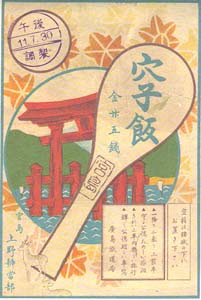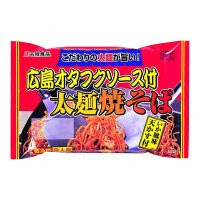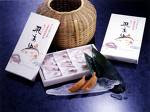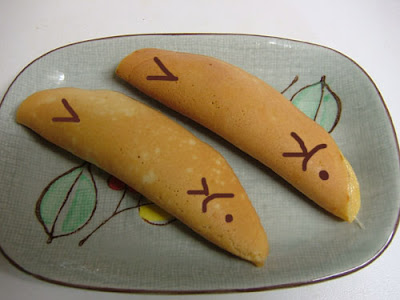::::::::::::::::::::::::::::::::::::::::::::::::::::::::::::::::::::::::::::::::::::::::::::::::::::
Hokkaido, Hokkaidoo 北海道 ほっかいどう
Matsumae 松前, one of the oldest port towns in Hokkaido, used to be busy during the summer months in the Edo period.
Matsumae at that time was almost identical with the old name of Ezo / Hokkaido.
. Matsumae wataru 松前渡る (まつまえわたる)
crossing over to Matsumae
kigo for early Summer
. Hokkaido Folk Toys .
:::::::::::::::::::::::::::::::::::::::::::::::::::::::::::::::::::::::::::::::::::::::::::::::::::
NHK news on April 2013
Pots used to cook fish date back 14,000 yrs.
Researchers have found traces of carbonized fish and other aquatic creatures on earthenware dating back about 14,000 years. The vessels have been unearthed at ruins in northern and central Japan.
The findings offer some of the earliest clues about the diet of prehistoric people.
A team of Japanese and British archaeologists released the findings in the online edition of the British science journal Nature.
The team says they examined carbide on the surface of earthenware found at 13 sites of ancient ruins around Japan. The ruins date back between 15,000 and 12,000 years to the early Jomon period.
They detected lipids from fish products in the scorched residue on the surface of pots that were unearthed at sites in Hokkaido, northern Japan, and Fukui Prefecture in central Japan.
The Taisho-3 ruins in Hokkaido date back 14,000 years, and the Torihama shell mound in Fukui 12,000 years.
The team says the carbonized residue from the ruins in Hokkaido could be of cooked salmon since the site is located inland. Ancient people are believed to have caught salmon as they swam upstream to spawn.
20,000-year-old pots unearthed last June in the Chinese province of Jiangxi are considered the earliest evidence so far of the prehistoric practice of cooking food in pots.
The team says their latest findings are the earliest clues indicating exactly what kind of food was cooked.
Researcher Yasutami Nishida says ancient people are believed to have used earthenware pots for cooking acorns and other plants.
He says the latest findings show that Jomon people also cooked fish in pots shortly after they started using them as cooking utensils.
http://www3.nhk.or.jp/nhkworld/english/news/20130411_02.html
:::::::::::::::::::::::::::::::::::::::::::::::::::::::::::::::::::::::::::::::::::::::::::::::::::
Lately, some kinds of rice are grown in Hokkaido too, put the staple is still potatoes.

Hokkaido Specialities Exhibition
A similar one was in my town, Oktober 2008.
Otaru's sushi-bar street "Otaru Sushiya-dori"
Cheese and butter production started in Hokkaido in the Meiji Era.
Hakodate Morning Market
The roots of the market are in farmers selling their products in the plaza in front of Hakodate Station after World War Two.
There are currently over 450 shops chiefly handling crab, salmon, salmon roe, chum salmon and other fresh seafood caught in the ocean around Hokkaido, but also including vegetables, fruit, dried goods, snacks, clothing, everyday sundries, and a wide variety of items.
Visitors can also enjoy meals made from fresh ingredients at restaurants in the market, with a bowl of rice topped with sashimi being on of the most popular items.
The market is very bustling, with over 1.8 million shoppers visiting each year.
www.japan-i.jp
Hakodate Free Market (jiyuu ichiba 自由市場)
Hakodate Cheap Marked of Nakajima (Nakajima kenbai 中島廉売)
„Ausverkaufsmarkt von Nakajima“
Hokkaido has the biggest production of buckwheat (soba) in Japan, especially in Sorachi and Tokachi.
'Hidaka beef' 日高牛 Hidakagyuu
'Shiraoi beef' 白老牛 Shiraoigyuu
Some areas like Otaru, Hakodate, Furano, Yoichi and others produce wine, since about 30 years.
Sapporo Beer
Sapporo Beer Museum
References : Sapporo Beer
Local Beer 北海道の地ビール jibiiru
Reference : www.BEER/hokkaido / 北海道の地ビール
. . . CLICK here for local beer Photos !

:::::::::::::::::::::::::::::::::::::::::::::::::::::::::::::::::::::::::::::::::::::::::::::::::::
Ainu Food ... アイヌ料理
:::::::::::::::::::::::::::::::::::::::::::::::::::::::::::::::::::::::::::::::::::::::::::::::::::
Bieicho, Biecho, the most beautiful village with its colorful hills.
北海道 美瑛町
grows potatoes and pumpkin. with Potato tower packaging.
. . . CLICK here for Photos !
Hill with many colors, shikisai no oka 色彩の丘
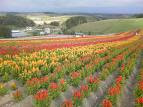
10 people took the initiative to plant colorful flowers, replanting every three to four weeks, all by hand.
One farmer also re-planted the delicate red wheat (akamugi 赤麦) to re-create the landscape.

From this red wheat they produce a local beer (jibiiru)
Akamugi Senretsu 麦秋鮮烈

The original "Red Wheat Hill"
Another product of the local farmers is milk tofu, gyuunyuu doofu 牛乳豆腐 gyunyu tofu
. . . CLICK here for Photos !
Made from the first milk after a calf is born. Milk is heated and some vinegar added to make it curdle. Eaten with some wasabi and soysauce.
shirakaba jueki shiroppu 白樺樹液から白樺シロップ
syrup from birch sap, shirakaba shiroppu
. . . CLICK here for Photos !
mori no shizuku 森の雫 "a drop from the forest" - drink
juekinabe, jueki nabe 樹液鍋 hodgepodge with tree sap
The sap is taken from birch trees in spring, and added to the stew. Almost like maple syrup.
Biei Buta Roosu 美瑛産豚ロース Pork roast from Biei Village
. . . CLICK here for Photos !
:::::::::::::::::::::::::::::::::::::::::::::::::::::::::::::::::::::::::::::::::::::::::::::::::::

Hokkaido Milk Beer : Milk + Beer = Bilk
From Abashiri beer Brewery. With 30 % milk.
NAKASHIBETSU
The idea for the drink was conceived after dairy firms threw out a huge amount of surplus milk in March last year. The son of the manager of a liquor store in Nakashibetsu, whose main industry is dairy farming, suggested the idea of producing the milk beer to local brewery Abashiri Beer.
.Milk + Beer = Bilk !
MORE : Abashiri Beer 網走ビール
Hamanasu Draft はまなすビール / ハマナスドラフト
Ryuhyo Draft 流氷DRAFT
:::::::::::::::::::::::::::::::::::::::::::::::::::::::::::::::::::::::::::::::::::::::::::::::::::
Trappist Butter from Hakodate
函館のトラピストバター
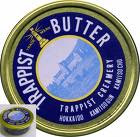
Trappist Monastery in Hakodate
函館トラピスト修道院
The Trappist Monastery was built in 1896 as the first monastery in Japan, and its official name is “Our Lady of the Lighthouse Trappist (Order of Cistercians of the Strict Observance) Monastery.”
The Trappist cookies, butter, butter candy, and jam made at the monastery are highly popular as Hokkaido’s local specialties.
source : www.japan-i.jp/explorejapan
Trappist cockies トラピストクッキー kukkii
Trappist butter drops トラピストバター飴 bataa ame
Trappist waffles トラピストガレット garetto (galette)
These are waffles or pancakes made from buckwheat flour.
. . . CLICK here for Photos !
Hakodate und das Trappistenkloster und Takadaya Kahei 高田屋嘉兵衛
:::::::::::::::::::::::::::::::::::::::::::::::::::::::::::::::::::::::::::::::::::::::::::::::::::
Kitami Town 北見市 Kitami-Shi
famous for its peppermint production, hakka ハッカ .
hakka amanattoo ハッカ甘納豆 black beans with white peppermint
CLICK here for PHOTOS !
hakka yookan ハッカ羊羹
CLICK here for PHOTOS !
hakka senbei ハッカせんべい
hakka sake ハッカ酒
In this town, as in many other of Hokkaido, they put the sweet beans natto in sekihan rice.
Reference . Kitami Pepperint
.................................................................................
kigo for late summer
hakka karu 薄荷刈る (はっかかる) cutting peppermint
harvesting pepeprming
..... hakkakari, hakka kari 薄荷刈(はっかかり) peppermint harvest
kigo for early autumn
hakka no hana 薄荷の花 (はっかのはな) peppermint flowers
megusa めぐさ
ooararagi おおあららぎ
Pferrerminzbluete
. . . CLICK here for Photos !
wild peppermint
the dock leaf's shadow
a bee clings to it
Alan Summers
Basho Anthology 2001, Japan
(selected by Tadashi Kondo)
:::::::::::::::::::::::::::::::::::::::::::::::::::::::::::::::::::::::::::::::::::::::::::::::::::::
Hakodate asaichi, asa ichi 函館 朝市 morning market in Hakodate
some specialities
ikasumi aisu イカ墨アイス soft cream with squid ink
also ikasumi to banira イカ墨&バニラ mixed with vanilla ice cream
and
ikasumi rooru イカ墨ロール squid ink roll cake
CLICK here for PHOTOS !
kaniman, kani man ”かにまん” manju filled with crab meat
CLICK here for PHOTOS !
nebari konbu ねばり昆布 sticky kombu
called: gagome . がごめ昆布
very tasty in miso soup
CLICK here for PHOTOS !
:::::::::::::::::::::::::::::::::::::::::::::::::::::::::::::::::::::::::::::::::::::::::::::::::::::
ageimo, age-imo あげいも fried potatoes
The ones from Nakayama pass 中山峠 are most famous. Danshaku potatoes are fried in butter.
.................................................................................
bataa バター butter
also many butter cookies
. . . CLICK here for Photos !
When the butter production first begun in Hokkaido, the people did not know how to use it with western food. So they put it on the Japanese dishes they were used to. In the cold winter of Hokkaido, butter provided the poor people with enough calories to survive.
bataa shooyu gohan バター醤油ご飯
cooked rice with a slice of butter and soy sauce
the normal mix of a family when eating at home.
The habit of putting butter on bread and potatoes is well alive even when eating rice.
. . . CLICK here for Photos !

bataa koohii バターコーヒー butter coffee
a piece of butter in the coffe !
. . . CLICK here for Photos !
bataa miso バター味噌
miso soup with a slice of butter
. . . CLICK here for Photos !
.................................................................................
butadon 豚丼 rice with pork meat
Dish from the early settlers of Hokkaido, first prepared about 70 years ago in a restaurant in Obihiro. It was for the rich people, with rice, but later spread to all people.
chiizu チーズ cheese from Hokkaido
also a lot of cheese cake, see Sweets from Hokkaido
. . . CLICK here for Photos !
chikuwapan, chikuwa pan ちくわぱん bread roll with a chikuwa inside
The chikuwa itself is filled with tuna fish flakes.
. . . CLICK here for Photos !
There is also a natto chikuwa pan ”納豆竹輪パン”, where the chikuwa is filled with natto sticky fermented beans.
and a bread roll with kamaboko pan rooru かまぼこパンロール
from Otaru 小樽
. . . CLICK here for Photos !
::::::::::::::::::::::::::::::::::::::::::::::::::::::::::::::::::::::::::::::::::::::::::::::::::::

chirashi ちらし fried vegetables on rice
with a helping of ping pickled ginger in the middle.
in the style that is Chinese food
chuuka chirashi 中華ちらし
Speciality of the town of Obihiro.
chirashi in other parts of Japan denotes a kind of sushi.
. . . CLICK here for Photos !
::::::::::::::::::::::::::::::::::::::::::::::::::::::::::::::::::::::::::::::::::::::::::::::::::::
esukaroppu エスカロップ escaloppe
from Nemuro. esuka エスカ. A cutlet is placed on fried rice, with demi-glace sauce.
Sometimes ketchup is added. Developed in 1963 in a western restaurant.
gyuunyuu 牛乳 Milk products
gyuunyuu doofu 牛乳豆腐 "milk tofu"
hishi no mi 菱の実 ひしのみ water chestnut
like this or in miso soup
. . . CLICK here for Photos !
hizu namasu 氷頭(ひず)なます vinegared fish head namasu
(kigo for autumn)
hokki karee ほっきカレー hokki shell curry
hokki long shell, Spisula sachalinensis.
In the language of the Ainu, it sounds "hokku sei". The shell is black or light brown
kurohokki, chabokki. The black one has jelly-like meat and is valued a lot for Sashimi, sushi, grilling with salt or frying with butter. Also with miso dressing or in soups.
. . . . . IKA SQUID Tintenfisch
ikameshi イカめし squid with rice
a whole squid is filled with rice and boiled in soy sauce-based soup. The legs of the squid are cut finely and also eaten with mountain vegetables.
Station lunchbox from Hakodate line, Mori Station 函館本線森駅の駅弁.
In Hokkaido, common squid and spear squid are fished in summer and autumn. Mostly off the Tsugaru straights.
ikasoomen いかソーメン squid cut finely like somen noodles.
a kind of ika sashimi. From Hakodate.
Often eaten for breakfast.
ika-shiokara .. squid and fish guts pickled in salt
ikuradon, ikura don イクラ丼 rice with salmon roe
with a bit of soy sauce, the typical taste of Hokkaido.
imobataa いもバター potatoes with butter
imodango いも団子 potato dumplings
A snack for children, with a different flavor in every home.
imomochi, kabochamochi いももち・かぼちゃもち
mochi from potatoes or pumpkin
to be put into the Genghis Kahn Hodgepodge ジンギスカン nabe.
ishikarinabe, ishikari nabe 石狩鍋
whole salmon and vegetables grilled on a hot plate
A simple meal of the local fishermen. The name comes from the river Ishikarigawa.
Some vegetables, satoimo potatoes and cabbage or potatoes are added.
ちゃんちゃん焼き Chanchan yaki
imomochi いももち mochi with potatoes
can be fried or put into soup. Some are made with katakuriko, others with wheat flour.
jagaimo じゃがいも Potatoes, potato, Kartoffeln
Danshaku, danshaku imo, May Queen. Kitaakari, Waseshiro, Matilda, Tooya, Cynthia.
Baron Danshaku Kawada Ryuukichi (1856-1951) introduced potatoes to Hokkaido.
They were known in Kyushu as "oranda imo" potatoes from Holland.
The name comes from the harbour of .. Jakarta ... jagatara ... jagaimo.
New varieties of potatoes
jagabataa ジャガバター potatoes with butter
jingisukan Chingis Khan nabe ジンギスカン
Hodgepodge with lamb and mutton meat
Genghis Khan stew
Each home and restaurant has a different style and sauce.
Mostly eaten outside as barbeque.
Dschingis Khan Eintopf
. Genghis Khan and Haiku
kabochajiruko かぼちゃ汁粉 sweet soup with pumpkin
From Obihiro. When no rice was available in Hokkaido, pumpkin was added instead of mochi.
kajikajiru かじか汁 soup with kajika fish
Cottus kazika.
Has a lot of fish bones. With fish, potatoes, carrots, konbu dashi, miso, leek and others to keep hot during the cold winter months.
. . . CLICK here for Photos !
kaisendon, kaisen don 海鮮丼 rice with seafood
Crabs, salmon roe, hotategai shells and other seafood is placed of steaming hot rice.
kakimeshi カキめし rice with oysters
a special from the station of 厚岸駅
北海道旅客鉄道(JR北海道)根室本線(花咲線)厚岸駅前.
The oysters are boiled and with this liquid rice is cooked. Hijiki seaweed is added, also shibugai ツブ貝 and asari shells, shiitake mushrooms, fuki butterbur and other vegetables. The rice is mixed with all this ingredients and "Good Luck Gods" tsukemono 福神漬け and takuan radish pickles are added.
.................................................................................
kani 蟹 かに crabs
There are four types of crabs caught in Hokkaido, king crab, queen crab, hairy crab and hanasaki crab. Hanasaki are caught on the coast of Hanasaki peninsula in Nemuro.
kani no teppoojiru カニのてっぽう汁 crab leg soup
teppojiru
The legs of crabs are crushed and added to white miso soup. When eating, the leg meat is pushed out of the shell "like a bullet out of a gun (teppoo)".
Nemuro hanasakigani are best 花咲カニ / 花咲蟹.
. . . CLICK here for Photos !
.................................................................................
kujirajiru くじら汁 whalemeat soup
Salted whalemeat is cooked with vegetables. Usually in a big pot, often for the new year. "A big fish brings big luck"!
Garlic, leek, cabbage, radish, carrots, warabi, zenmai and others are addes.
mamepan 豆パン bread with sweet beans
(amanatto 甘納豆, sweet beans) also served for school luncheons after the war.
matatabi, furuutsu matatabi フルーツまたたび
fruit of matatabi silvervine
from Abashiri 網走産完熟またたび果実「フルーツまたたび」
meron メロン melons
Yubari melons, Furano melons and Kyowa melons.
In greenhouses from April to October. Rupiah Red, Yubari King, King Melty.
"Densuke-suika" from of Tooma , a black jumbo watermelon
Matsumaezuke, matsumae tsukemono 松前漬け
pickled seaweed and fish rogen
with soy sauce, mirin sugar and other ingredients.
ninjin にんじん 人参 carrots
about 30% of the growth in Japan. Produced in Furano from April to October.
nishinzuke, nishin tsukemono にしん漬け pickles herring
Herring meat, cabbage, radish, carrots, chili peppers and others are pickled with salt for about 2 months.
orientaru raisu オリエンタルライス oriental rice
a kind of dry curry, with low-fat salami from local cows. On top of this a special demi-glace sauce.
From Nemuro.
oshiruko kabocha お汁粉 oshiruko soup with pumpkin
In the area of Obihiro, Tokachi, they grow red azuki beans and green round pumpkin. White mochi are only put in the soup for the New Year, otherwise they use pumpkin pieces or pumpkin dumplings (kabocha dango かぼちゃ団子 )
. . . CLICK here for soup Photos !
. . . CLICK here for dumpling Photos !
Potato Curry Pizza, Hokkaido Style
................................................................................
raamen ラーメン noodle soup
Asahi Ramen, Sapporo Ramen, Hakodate Ramen, Kushiro Ramen, Kawakami Ramen and others.
..... karee raamen 室蘭カレーラーメン ramen with curry sauce
from Muroran city
. . . CLICK here for Photos !
chikyuumisaki karee raamen 地球岬カレーラーメン
Has been first prepared in Showa 46. It is now often eaten as the last dish (シメ 〆 shime) in a yakitoria restaurant, after drinking and eating along. Sometimes you even get a portion of cooked rice in the leftover broth to finish it.
Hakodate basu raamen バスラーメン 函館

Ramen served from a bus which is driving around.
It has become so popular, it is even sold in packages online now.
. . . CLICK here for Photos !
................................................................................
ramu chanchan yaki ラムちゃんちゃん焼
chanchan grill-cooking of mutton and lamb with vetetables and misopaste.
ruibe ルイベ "thawing food"
a kind of natural frozen sashimi, not only salmon.
See AINU FOOD>
sanpeijiru 三平汁 herring soup
Originally herring was used, but now salted salmon is mostly used. Fish innards are also used. Boiled with vegetables, it is a taste of home. Eaten in winter to keep warm.
sekihan 赤飯 rice boiled with red azuki-beans
sometimes 金時豆 kintoki mame are used.
:::::::::::::::::::::::::::::::::::::::::::::::::::::::::::::::::::::::::::::::::::::::::::::::::::::
. . . . . SHAKE / SAKE / SALMON
shake chanchan yaki, chanchanyaki 鮭ちゃんちゃん焼mixed grill with salmon. grill-cooked on a hot plate.
The name comes for its easy way to mix things on the plate ... chan chan
or
Because father made it, he is also called CHAN.
shake no konbumaki サケの昆布巻き salmon wrapped in kombu seaweed
A typical dish of Hokkaido. Boiled with sake, ginger, sugar, soy sauce, mirin.
Also wrapped in konbu are herring, tarako roe or shishamo fish.
新巻さけ shin makisake
shake no roorukyabetsu 鮭のロールキャベツ Krautwickel mit Lachs
sake toba さけとば smoked salmon strips

shake to jagaimo no suupuni 鮭とじゃがいものスープ煮 soup with salmon and potatoes
sujiko 筋子(すじこ) salted salmon roe
ruibe ルイベ "thawing food", frozen sashimi type
izushi fermented fish
SAKE, salmon, a kigo
Keta-Lachs. Oncorhynchus keta
:::::::::::::::::::::::::::::::::::::::::::::::::::::::::::::::::::::::::::::::::::::::::::::::::::::
shikaniku suteeki, シカ肉ステーキ deer steak
With its low fat it is slowly becoming popular in Hokkaido as health food.
shioyakisoba, shio yakisoba 塩やきそば fried noodles, salt flavor
with hotate and onions as dressing.
From Obihiro
. . . CLICK here for Photos !
supearibu beekon スペアリブベーコン spearribs and bacon
..... chorisoo チョリソー coarsely ground saussages
..... レモン&パセリ lemon and parsely saussages
suupukaree, スープカレー soup curry
From Sapporo.
Curry ingredients are cut to big pieces and boiled in the soup. Vegetables, potatoes, carrots, paprica. Some even ladle this over boiled rice.
. . . CLICK here for Photos !
.................................................................................
tako no atama タコの頭 head of the octopus
This is mostly eaten in Hokkaido. The mizudako has rather a big head which can not be sold well on mainland Japan. So it is used for sushi, sashimi and many other dishes, even for takoyaki dumplings.
. . . CLICK here for Photos !
tako no shabushabu たこのしゃぶしゃぶ octopus shabushabu
Oktopus from From Wakkanai, Rebun, Rishiri islands.
.................................................................................
tamanegi たまねぎ 玉ねぎ onions
first indroduced from North America, now almost half of the Japanese production. Grown in Abashiri, Furano, Ishikari and Sorachi from April to September.
toomorokoshi とうもろこし maize, corn, sweet corn
Mostly in Tokachi from March to September.
Sold in street stands in Odori Park in Sapporo in Summer.
tontoro yakidon, トントロ焼き丼, tontoro don トントロ丼 rice with tontoro
ton トン pig
. . . CLICK here for Photos !
uchidazerigani ryoori ウチダザリガニ料理 crabs
These crabs are about 10 cm long, a large kind of zarigani crawfish.
Eaten in Akan. Their bright red color makes you appetite!
. . . CLICK here for Photos !
uni, nama uni donburi 生ウニどんぶり(丼)
rice with raw sea urchin, unidon
'uni-kurage' combination of sea urchin eggs and jellyfish
wakasagi no tenpura わかさぎの天ぷら tempura of pond smelt
Best from autumn to winter.
wasabi no ha no shooyuzuke わさびの葉の醤油漬け soy pickles of wasabi leaves
Tasts good with rice or in onigiri rice balls. Tasts like エゴマ egoma leaves soy pickles.
 wasabi from Noboribetsu
wasabi from Noboribetsu登別のわさび
This has started about 100 years ago, when the local doctor found a spring with very good and plentiful fresh water. He introduced the wasabi fields and used the wasabi as a kind of medicine for the villagers, to prevent food poisoning in the hot summer days. Now in the 4th generation, they keep these fields in good order and provide wasabi dishes of all kinds.
. Oni 登別の鬼 The Demons of Noboribetsu .
yamawasabi やまわさび horseradish
. . . CLICK here for Photos !
This is the white kind, introduced from Europa during the Meiji time. They are planted in large fields and eaten to many dishes in Hokkaid.
Meerrettich
Yezo shika, Ezo shika えぞ鹿肉 venison from Ezo deer
Yezo deer
Offered by "Daichi o mamoru kai" Association to preserve the earth.
The meet is low in calories and high in iron content.
source : 大地を守る会
yookan rooru ようかんロール /羊羹ロール bread with sweet bean paste
pan ni yooka パンに羊羹
and other combinations of bread and yookan paste, yookan suiitsu スイーツ
CLICK here for PHOTOS !
yurine ゆり根 百合根 bulbs of lilies, lily bulb
in season from august to february
They are full of nutrients and part of Chinese medicines.
Contains vitamin B, protein and calcium.
Prepared in chawanmushi and manjuu, mostly in the tempel quisine of Kyoto.
yurine kinton ゆり根きんとん sweat potato paste
yurine to gyuuniku to kurokoshoo itame ゆり根と牛肉の黒こしょう炒め
yurine no amani ゆり根の甘煮 sweet simmerd
yurine-iri hangaagu ゆり根入りハンバーグ hamburgers
source : Kikkoman recipes
In Chinese Medicine, it is called hyakugoo 百合(ひゃくごう). For coughing, nervosity, sleeplessness, nervous tiredness and other nervous ailments.
It grows in the mountains of Japan. Lilium auratum
Called Oniyuri, himeyuri and other names.
山野のオニユリ、新潟県下田村のヒメサユリ、新潟県角田山のスカシユリ、新潟県奥只見のコオニユリ、新潟県柏崎市のタカサゴユリ、粟ケ岳のヒメサユリ、美しい海岸で知られる瀬波海岸のイワユリ、妙高市のササユリ、佐渡の海岸岩場のイワユリ、種子島などに岩場、崖に自生するテッポウユリ.
source : www.e-yakusou.com
zangi ザンギ deep-fried chicken
鶏の唐揚げの一種. with soy sauce and garlic flavor, meat is marinated over night in the refrigerator
. . . CLICK here for Photos !
:::::::::::::::::::::::::::::::::::::::::::::::::::::::::::::::::::::::::::::::::::::::::::::::::::::
. . . . . . . . . some more dishes
tako negi chiizu age ... Kamaboko

gyooja ninniku iri no gyooja (gyooza) dumplings with victory onion
"garlic for mountain ascetics", victory onion, is the main plant of Ainu dishes.
wild onion, Ainu onion, Ainu negi, 行者大蒜
with Allium victorialis L. subsp. platyphyllum.
Old name is araragi アララギ.
Mountain ascetics used to eat it to bear through hardships. It is also a very powerful aphrodisiacum and was later forbidden for them.
Wild garlic, bear's garlic, Allium ursinum is a different species.
Lange Siegwurz, Long-rooted Garlic, Alpine leek
WASHOKU
ninniku 蒜 (にんにく(ニンニク)) garlic
tomoedon 巴丼 "comma-shaped swirl bowl of rice"
with hotate scallops, sea urchins, salmon roe placed to make a nice pattern.
. . . CLICK here for Photos !
most hotategai scallops are fished along the coast of Hokkaido, from March to April they are larger with eggs.
::::::::::::::::::::::::::::::::::::::::::::::::::::::::::::::::::::::::::::::::::::::::::::::::::::
Local Sake from Hokkaido 北海道 地酒
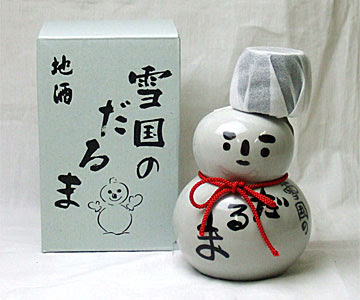
Click for more photos.
::::::::::::::::::::::::::::::::::::::::::::::::::::::::::::::::::::::::::::::::::::::::::::::::::::
SWEETS from HOKKAIDO
*****************************
Worldwide use
*****************************
Things found on the way
History of Milk and Cheese in Japan
miruku ミルク milk
kanraku 乾酪 cheese
gyuuraku 牛酪 butter
Via Korea the production of milk, butter and even cheese (so 蘇 ) was known before the Heian period. But when Shotoku Taishi elevated Buddhism and meat was forbideen to eat, the production stopped.
The 7. Shogun Yoshimune sponsored the import of cows from India and the daimyo Satomi in Chiba supervised the production of dairy products as a kind of medicine.
Maeda Tomekichi was the first to sell fresh milk in Yokahama around 1863, having studied from Holland how to handle cows.
Since the Meiji period, Hokkaido became the center of dairy products, thanks to its vast grazing grounds and fresh water. Holstein cows are most popular and produce about 8000 kg per year each.
The village Tsuruimura 鶴居村 (つるいむら) was the first "cow village" in Kushiro, Hokkaido.
*****************************
HAIKU
. Sapporo matsuri 札幌祭 (さっぽろまつり)
Sapporo festival
kigo for mid-summer
*****************************
Related words
. WASHOKU
Milk, Butter, Cheese and other Milk Products
***** WASHOKU : Regional Japanese Dishes
- #hokkaido -
:::::::::::::::::::::::::::::::::::::::::::::::::::::::::::::::::::::::::::::::::::::::::::::::::::

